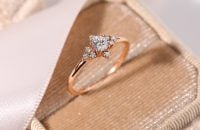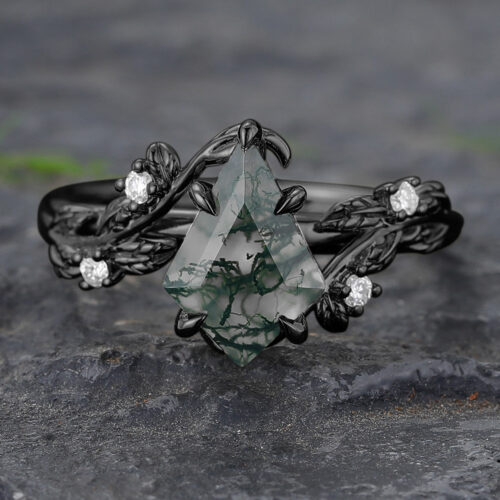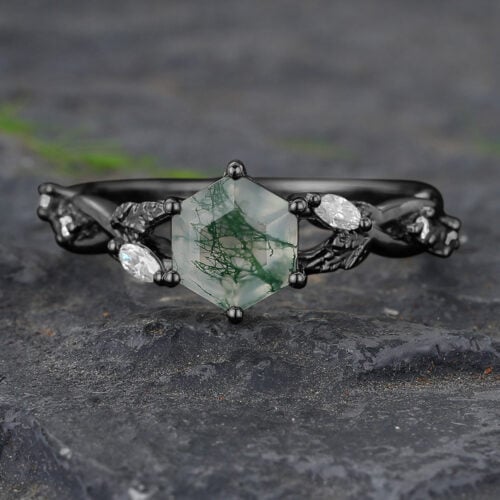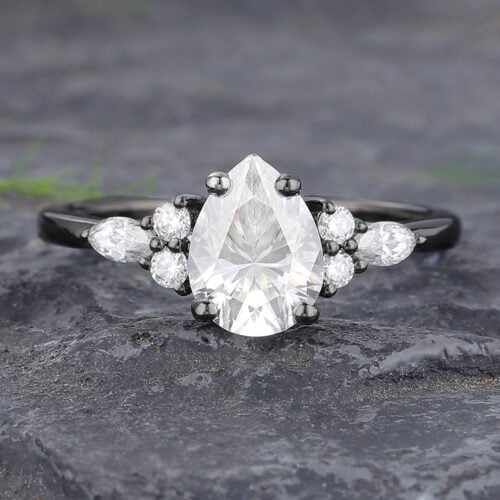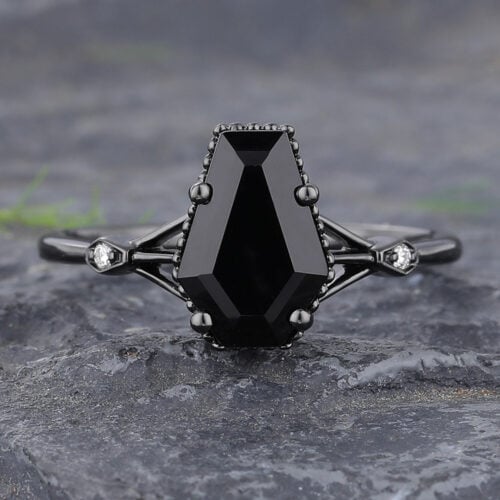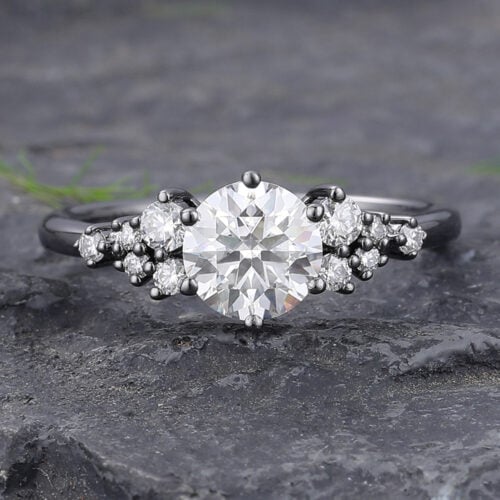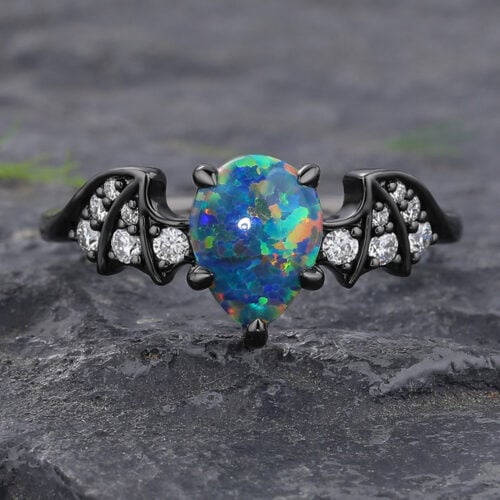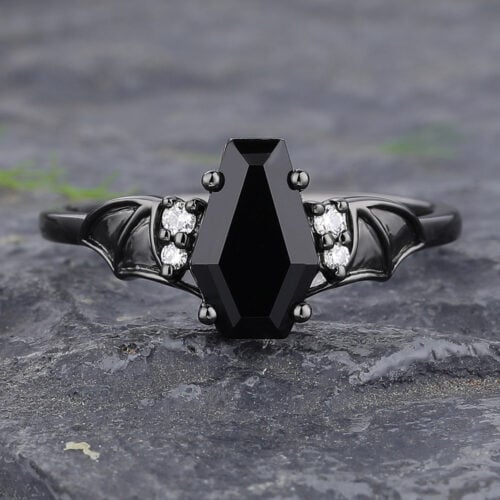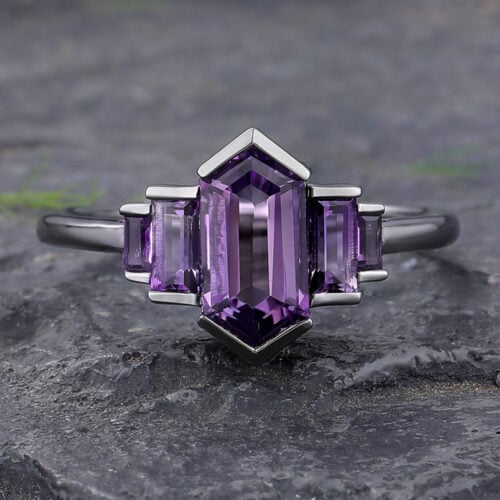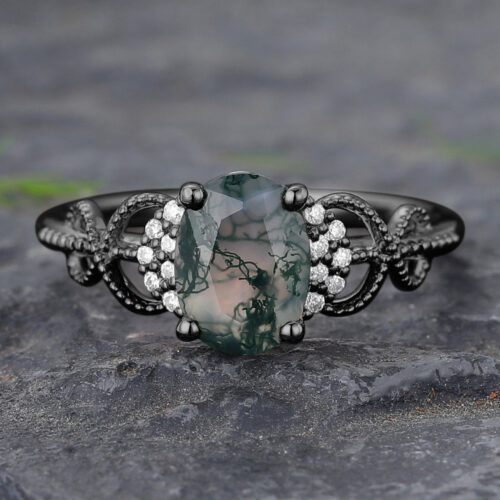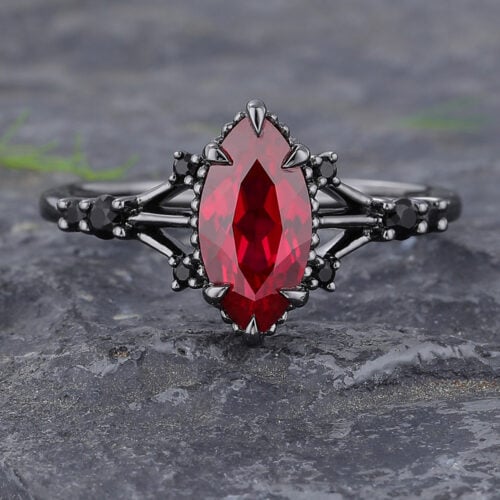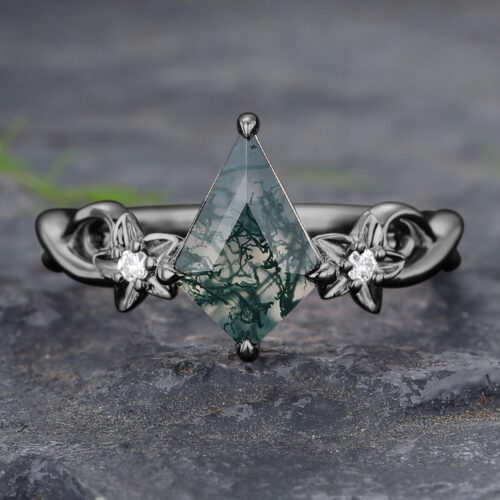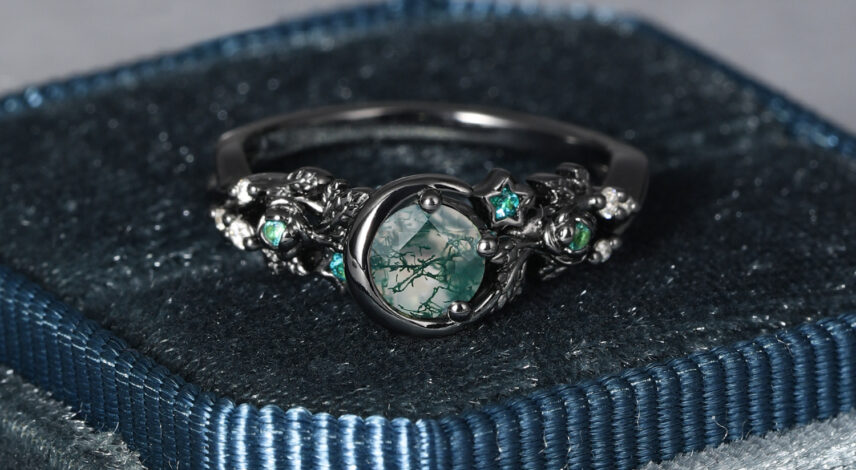
What Is Black Gold? Everything You Need to Know About Black Gold Jewelry
0 commentsIn recent years, black gold jewelry has emerged as one of the most captivating trends in the luxury fashion world.
You might be wondering: What exactly is black gold? How is it made? Is it durable enough for everyday wear — and is it a good choice for fine jewelry, especially engagement rings and wedding bands?
To answer these questions, we’ve put together this guide to introduce this “non-traditional” precious metal finish.
What Is Black Gold?
Black gold isn’t a naturally black metal. Just like every gold color other than yellow, it requires additional processing to achieve its distinctive shade.
In the jewelry industry, you can think of black gold quite simply as gold with a black surface finish.
Many people assume black gold is created by mixing pure gold with black-colored metals, but that’s not the case.
Black gold ≠ gold alloyed with black substances.
This distinction matters. Gold doesn’t naturally turn black just because another metal is mixed in. Even when alloyed with darker elements such as cobalt or chromium, the result is only a deep grey — never the rich, saturated black that jewelers recognize as true “black gold.”
Real black gold comes from surface treatments, not alloying.
Popular Black Gold Rings
How Is Black Gold Made?
Many online explanations of black gold are vague or inaccurate. In professional jewelry making, black gold is typically produced through three main techniques:
1. Black Rhodium Plating (Electroplating) — the Most Common Method
Electroplated black rhodium is the most widely used method for producing black gold in commercial jewelry. The process is similar to white-gold finishing: a thin layer of rhodium (black) is plated onto the gold base (typically 10k, 14k, or 18k).
At this point, some may ask, “Isn’t rhodium naturally silver-white?”
Yes — pure rhodium is bright silver-white. However, black rhodium isn’t simply “darkened rhodium.” It is produced using specialized black-rhodium plating baths, which contain additives that modify how the rhodium crystals grow on the metal’s surface. These additives create a microstructure that absorbs and scatters more light, resulting in a dark grey to deep black appearance.
Plating parameters — such as current density, temperature, solution pH, and the cleanliness of the base metal — also influence the final shade. Precise control yields the familiar white, mirror-bright rhodium finish; a different formulation and microstructure yield black or gunmetal tones.
- White rhodium → dense, fine-grained structure → strong light reflection
- Black rhodium → modified, coarser or more porous structure → increased light absorption/scattering
These differences come from physical microstructure, not from a change in rhodium’s elemental color.
Pros & Cons
- 🟢 Luxurious shine
- 🟢 Safe, hypoallergenic
- 🟢 Widely available
- 🔴 The coating is thin (microns)
- 🔴 May fade over years of wear and requires re-plating
Best for: Fine jewelry, fashion-forward designs, engagement rings with a modern edge.
2. Surface Oxidation — for an Organic, Matte Black Look
This method relies on chemical oxidation of the alloying metals, not gold itself.
Gold is chemically inert, but alloys such as silver or copper in 10K/14K/18K gold can form a darkened patina when treated with specific oxidizing agents.
Pros & Cons
- 🟢 Creates a matte or antique black tone
- 🟢 Ideal for rustic, artistic, or vintage-style jewelry
- 🔴 The layer is thin and can rub off faster than plating
- 🔴 Requires gentle handling and occasional touch-ups
Best for: Handcrafted pieces, artisanal jewelry, designs inspired by gothic or earthy aesthetics.
3. PVD Coating (Physical Vapor Deposition) — Durable & Modern
Technically superior to electroplating, PVD deposits an extremely thin yet hard layer of black material(usually black titanium compound)onto the gold.
Pros & Cons
- 🟢 More durable than standard plating
- 🟢 Highly resistant to wear
- 🟢 Even, consistent color
- 🔴 Requires specialized equipment
- 🔴 Costs more than rhodium plating
Best for: Daily-wear rings such as men’s wedding bands, high-fashion pieces, and contemporary minimal designs.
All three of these methods are surface treatments, not internal alloy colors. So what are the differences in appearance and price among them? Take a look at the table:
| Method | Appearance | Price Range |
|---|---|---|
| Black Rhodium Plating | Glossy black, sleek | $ – $$ |
| Oxidation | Matte, antique black | $ – $$ |
| PVD Coating | Matte or satin black | $$ – $$$ |
❗ About Laser-Black Gold (Important Clarification)
You might see claims online that “laser-treated gold becomes permanently black and scratch-proof.”
This is not accurate.
- Femtosecond lasers can create black textures on certain metals
- But this technique is not stable, reliable, or common for gold jewelry
- It does not make the gold scratch-proof(the underlying gold remains soft)
- It is currently experimental, not a commercial jewelry method
This article excludes laser blackening as a practical jewelry technique because it is not used in professional production.
Is Black Gold Durable?
The durability of black gold depends on two factors:
the manufacturing method and the karat value of the gold base.
Method | Durability | Notes |
|---|---|---|
| Black Rhodium Plating | Moderate | May fade; can be re-plated. |
| Oxidation | Lower | Patina wears faster; best for light wear. |
| PVD Coating | High | Best durability for black gold jewelry. |
Durability Across Different Gold Karats: 10K > 14K > 18K (Lower-karat gold contains more alloy metals, making it harder and more resistant to wear. Higher-karat gold contains more pure gold, which is softer and more prone to bending or surface wear — though it is also more valuable and more expensive.)
If you want a black gold engagement ring that’s durable enough for daily wear and offers the best value, a 14K gold base with a PVD coating is typically the most practical and long-lasting option.
Why Is Black Gold Jewelry So Popular?
1. A Modern, Edgy Aesthetic
Black gold is an eye-catching alternative to traditional yellow or white gold. Its deep, dark hue adds an air of mystery and sophistication. The sleek, matte finish looks modern and pairs well with diamonds and other gemstones, often making them stand out more vividly. Its edgy aesthetic makes it particularly popular in fashion-forward circles and among those looking to make a statement.
2. Symbolism
Gold has always been associated with wealth and power, while black is often linked to mystery, elegance, and strength. Combining these two qualities, black gold can symbolize luxury with a hint of rebellion and individuality. This makes it especially appealing for those seeking a unique piece of jewelry that reflects their personal style or values.
3. Versatility
Black gold complements a wide range of styles. It can be dressed up for a formal event or worn casually, adding a touch of sophistication to everyday wear. It also pairs well with other metals like silver or rose gold, making it an adaptable choice for custom jewelry pieces.
Popular Black Gold Engagement Rings
How to Care for Black Gold Jewelry
Caring for black gold jewelry depends heavily on how the dark finish was created. Each method — from electroplating to laser treatment — has its own strengths and sensitivities. Proper cleaning and maintenance will help preserve the color, luster, and surface integrity of your piece for years.
- Rhodium-Plated Black Gold:
Clean gently with a soft microfiber or jewelry cloth to remove dirt and oils. Avoid abrasive cleaners, toothpaste, or brushes that could wear away the thin rhodium layer. Keep your jewelry away from chemicals like chlorine, bleach, or perfume. For pieces that start to lose their color or shine, have them professionally re-plated every 1–3 years to restore their finish. - Oxidized Black Gold:
Since the black layer on oxidized gold is relatively delicate, avoid harsh scrubbing, polishing, or ultrasonic cleaning. Simply rinse with lukewarm water and mild soap, then dry thoroughly with a soft cloth. To prevent fading, store separately in a fabric-lined box or pouch and avoid prolonged water or sweat exposure. If the patina lightens, a jeweler can reapply oxidation. - PVD-Coated Black Gold: Regularly clean with lukewarm water and mild detergent, avoid contact with harsh chemicals, prevent scratching, and avoid prolonged exposure to water. Additionally, regularly inspect the jewelry, and if fading or wear is noticed, you can reapply the PVD coating.
- Laser-Treated Black Gold:
Laser-treated pieces are the most durable and low-maintenance. Clean with a non-abrasive jewelry cloth or rinse in warm water with mild soap. Although the black surface is permanent, it’s still best to avoid contact with strong acids or chlorine-based cleaners, which may dull the surface’s shine.
No matter the method, always store your black gold jewelry separately from other pieces to prevent scratches, and avoid excessive moisture or high heat. Proper care ensures your jewelry maintains its signature dark brilliance and timeless appeal.
Black Gold vs. Other Gold Colors
Here’s a simple comparison between black gold and traditional gold colors:
| Item | Black Gold | Yellow Gold | White Gold | Rose Gold |
|---|---|---|---|---|
| Appearance | Dark grey / black | Bright yellow | Cool silver-white | Warm pink-gold |
| How the Color Forms | Surface treatments (PVD / black rhodium / oxidation) | Natural gold color | Alloy + white rhodium plating | Copper in the alloy |
| Durability | Depends on method: PVD = strongest | High | Medium (needs re-plating) | High |
| Maintenance Level | Medium–High (black rhodium wears faster) | Low | Medium | Low |
| Price Range | Medium–High (due to coating process) | Medium–High (varies by karat) | Medium–High (includes rhodium plating) | Medium |
| Best For | Bold, modern, edgy | Classic, timeless | Minimal, modern | Romantic, vintage |
Is Black Gold Right for You?
If you’re seeking a piece of jewelry that stands out with sophistication, mystery, gothic style, and boldness, black gold could be the perfect choice for you. Its unique aesthetic, combined with its modern and edgy appeal, makes it an ideal option for those looking to make a statement with their jewelry. Whether you’re considering a black gold engagement ring, black gold wedding bands, necklace, or bracelet, you’ll find that this versatile metal pairs well with a variety of styles.
Ready to explore the beauty of black gold jewelry? Visit PattiRing and discover a stunning selection of black gold rings and other pieces that will make you feel truly special. Don’t wait—shop now and find the perfect piece that speaks to your personal style and elegance!
Black Gold FAQs
Yep, black gold is real gold! It’s usually made from 10K, 14K, or 18K gold, and then treated to give it that black look.
The price depends on the gold content and how it’s treated. Generally, the higher the karat (like 18K), the more expensive it is. Also, PVD coating tends to cost more than rhodium plating.
Yes, it can. Just like any rhodium-plated jewelry, the black coating can wear off over time due to things like friction or exposure to chemicals. But don’t worry — it’s totally normal, and you can always have it re-plated to make it look like new!
It depends on how often you wear it and your lifestyle. For example, if you wear a black rhodium ring every day, it might last anywhere from 6 to 18 months before it starts to fade. For things like necklaces, earrings, or bracelets, it can last 1–3 years.
Black gold really makes gemstones pop! It looks amazing with sparkly, transparent stones like diamonds or white moissanite, creating a high-contrast, eye-catching look. It also pairs well with dark gemstones like emeralds or black onyx, making their colors look even more intense and rich.
Yes, laser-treated black gold is permanent. It’s not just a coating — the laser actually changes the structure of the gold, so the color stays. The only thing to keep in mind is that while the color won’t fade, regular wear might cause some surface scratches over time. But overall, it’s pretty durable, and this method is still a bit rare.






